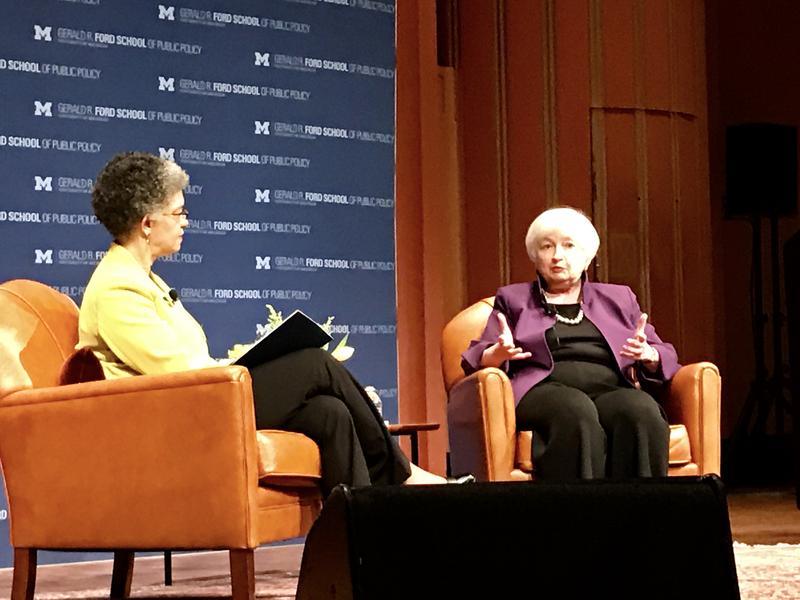Federal
Reserve Chair Janet Yellen said at a University of Michigan event today
the Fed plans to gradually raise short-term interest rates.
Yellen said the change in monetary policy comes after years of holding short-terms interest rates at low levels.
“I think we have a healthy economy now ... but it’s been a long time coming,” Yellen said.
Yellen said the current unemployment rate of 4.5% is “even a little bit below” what Yellen and her other colleagues at the Fed would consider “full employment.” She said inflation is “reasonably close” to the Fed’s stated goal of two percent.
She said the economy's current moderate level of growth is due in large part to increased consumer spending, but that the health of the housing market has improved, as well as investment spending and the global economy.
“Looking forward I think the economy is going to continue to grow at a moderate pace,” Yellen said.
Yellen, who assumed office in 2014, comes to the end of her term as Fed chair next year. She said the new monetary policy of the Fed, including raising interest rates, is focused on maintaining current levels of economic growth.
After the global financial crisis of the mid-2000s, the Fed did practically everything it could from a monetary policy perspective to increase consumer spending, including holding the “overnight” interest at nearly zero percent for years, according to Yellen.
But in those years, lowering short-term interest wasn’t enough. The Fed also bought treasury and mortgage-backed securities to lower long-term interest rates, according to Yellen. In addition, the Fed practiced what Yellen called “forward guidance,” reassuring the financial markets that interest rates would remain low.
“Before, we had our foot pressed down on the gas pedal trying to give the economy all the ‘oomph’ we possibly could,” Yellen said. “Now, [we want to be] allowing the economy to coast and remain on an even keel.”
Yellen also said it is important to begin rising interest rates before the economy “overheats."
“We don’t want to be in a position where we have to raise rates rapidly, which could conceivably cause another recession,” Yellen said. “We want to be ahead of the curve and not behind it.”
Yellen said the change in monetary policy comes after years of holding short-terms interest rates at low levels.
“I think we have a healthy economy now ... but it’s been a long time coming,” Yellen said.
Yellen said the current unemployment rate of 4.5% is “even a little bit below” what Yellen and her other colleagues at the Fed would consider “full employment.” She said inflation is “reasonably close” to the Fed’s stated goal of two percent.
She said the economy's current moderate level of growth is due in large part to increased consumer spending, but that the health of the housing market has improved, as well as investment spending and the global economy.
“Looking forward I think the economy is going to continue to grow at a moderate pace,” Yellen said.
Yellen, who assumed office in 2014, comes to the end of her term as Fed chair next year. She said the new monetary policy of the Fed, including raising interest rates, is focused on maintaining current levels of economic growth.
After the global financial crisis of the mid-2000s, the Fed did practically everything it could from a monetary policy perspective to increase consumer spending, including holding the “overnight” interest at nearly zero percent for years, according to Yellen.
But in those years, lowering short-term interest wasn’t enough. The Fed also bought treasury and mortgage-backed securities to lower long-term interest rates, according to Yellen. In addition, the Fed practiced what Yellen called “forward guidance,” reassuring the financial markets that interest rates would remain low.
“Before, we had our foot pressed down on the gas pedal trying to give the economy all the ‘oomph’ we possibly could,” Yellen said. “Now, [we want to be] allowing the economy to coast and remain on an even keel.”
Yellen also said it is important to begin rising interest rates before the economy “overheats."
“We don’t want to be in a position where we have to raise rates rapidly, which could conceivably cause another recession,” Yellen said. “We want to be ahead of the curve and not behind it.”



